Introduction
Understanding the impact of drones, specifically FPV drones, on tanks in the Ukrainian war is a complex challenge. Several factors contribute to this difficulty. First, there is the necessity of comprehensive and reliable data to evaluate the impact of a specific weapons system on the battlefield. Currently, data largely come from the diligent work of Andrew Perpetua and his OSINT team. As previously discussed, this database cannot be considered a precise and exhaustive count of events on the battlefield but does offer an invaluable glimpse into the ongoing war between the Armed Forces of Ukraine and Russia.
A second issue has materialized as a result of the rapid evolution of FPV drones, along with the training and tactics continuously developed by both sides. This conflict presents a unique opportunity to observe a military confrontation where both opponents are developing and refining a new platform from the ground up, perpetually improving it to meet their strategic needs. The pace at which FPV drone technology and operational tactics are evolving adds another layer of complexity to accurately assessing their impact.
Additionally, the sheer variety of drone models and their respective capabilities makes it challenging to draw broad conclusions. FPV drones differ in terms of range, payload, and manoeuvrability, among other factors. This variability influences how effectively they can target and damage enemy tanks. Moreover, both Ukrainian and Russian forces are constantly adapting their defensive and offensive strategies in response to drone threats, further complicating the assessment.
Another complicating factor is the quality of the visual data available. The identification of damaged, destroyed, or abandoned tanks often relies on video footage, which can vary significantly in quality. Poor video quality can hinder the accurate classification and counting of tanks, leading to potential underreporting or misidentification.
Toll on Russian tank fleet
Figure 1 provides a detailed breakdown of the impact of FPV drone strikes on Russian tanks from September 2023 to March 2024. The data is segmented into three categories: damaged, abandoned, and destroyed tanks, each represented by a different colour.
From September 2023, where there were 68 total strikes which predominantly damaged tanks, there was a notable increase to 104 total strikes in October 2023, with a small proportion of these tanks being abandoned and destroyed. November 2023 saw a slight decrease to 101 total strikes, maintaining a similar pattern to October. This was followed by a further decrease to 97 total strikes in December 2023. However, there was an increase to 128 total strikes in January 2024, followed by a significant rise to 142 total strikes in February 2024. The activity peaked in March 2024 with 176 total strikes, indicating a substantial escalation in FPV drone activity.
Overall, the totals amounted to 582 tanks damaged, making this the largest category and indicating that most FPV strikes result in damage rather than destruction or abandonment; 86 tanks were found to be abandoned, a smaller but notable portion, and 148 tanks destroyed; showing that while destruction is less common than damage, it is still a significant result.
The general trend indicates an increase in the number of FPV strikes over time, especially from January to March 2024. Damaged tanks consistently represent the majority of strikes each month. The number of destroyed tanks remains relatively steady, while abandoned tanks vary but also show an increase towards the later months.
This data suggests a growing reliance on FPV drones to target Russian tanks, with increasing effectiveness or deployment over time. The high number of damaged tanks could imply that many of these tanks are rendered inoperable or partially functional, impacting the operational capabilities of the Russian forces.

In support of the total tank losses, a breakdown of the financial impact of FPV drone strikes on Russian tanks from September 2023 to March 2024 is given by Figure 2. The data is segmented into three categories: destroyed, abandoned, and damaged tanks, each represented by a different colour (black, rose and red respectively). These should be considered as estimates, since each model fielded may have a different production cost. Furthermore, is difficult to judge the cost of a damaged tank since most of the time this is lost due to subsequent destruction via drone-dropped munition. For this reason, we decided to count 50% of the average cost when the tank is damaged, and 100% in the other cases. In September 2023, the total cost amounted to $117.5 million, with the majority of losses associated with damaged tanks and smaller proportions attributed to destroyed and abandoned tanks. In October 2023, the estimated costs increased significantly to $178.3 million, with damaged tanks still representing most of these. There was also a noticeable rise in losses related to destroyed and abandoned tanks. The estimated costs remained relatively stable in November 2023 at $179.8 million, maintaining a similar distribution among damaged, destroyed, and abandoned tanks.
December 2023 saw a slight increase in overall costs, to $194.3 million, with a continued emphasis on the financial impact of damaged tanks. January 2024 registered a significant rise in the cost of these losses to $249.4 million, indicating an escalation in FPV in both drone activity and effectiveness. This upward trend continued throughout February 2024, with estimated total costs reaching $288.6 million. The highest monthly estimated costs incurred to date were recorded in March 2024, at $308.9 million, reflecting a new high in both FPV drone activity and their impact on Russian armor.
Overall, these totals to date stand at: $843.9 million for damaged tanks, $243.6 million for abandoned tanks, and $429.2 million for destroyed tanks, resulting in an overall total cost of $1,516.7 million to the Russian war economy. The analysis illustrates the growing financial impact of FPV drones on Russian armored capabilities. The increasing monthly costs highlight the escalating effectiveness and deployment of FPV drones.
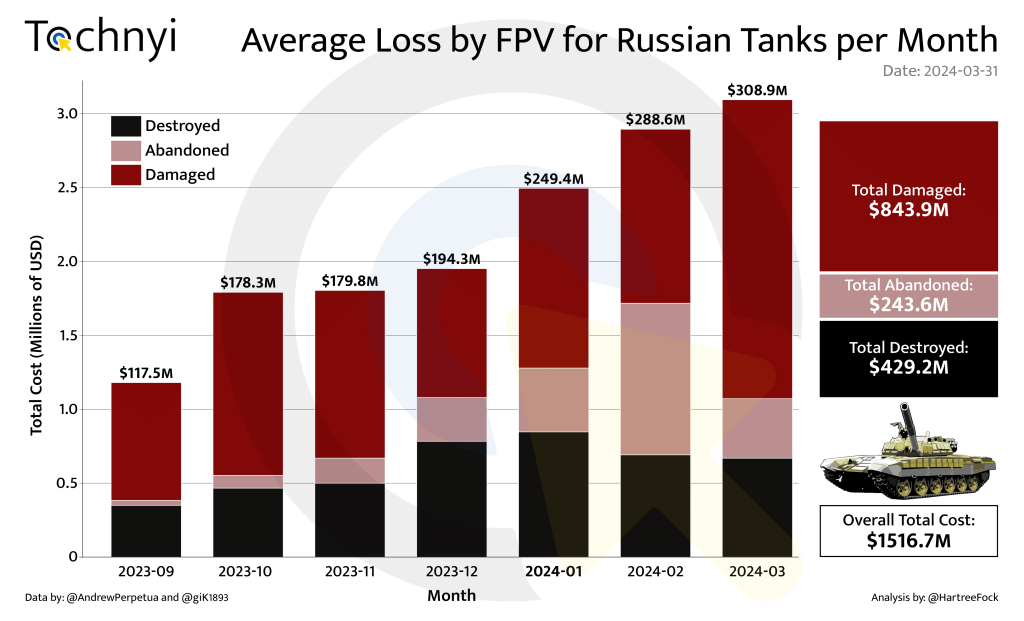
To understand the overall impact of the various types of tanks fielded by the Russian army, it is useful to categorize each strike for each tank type. The graph in Figure 3 shows the number of tanks destroyed, damaged, and abandoned for each kind. It is worth mentioning that a small number of tanks have not been identified due to the poor image resolution within available video data.
By looking at this chart, it becomes clear that the T-72 and T-80 are the tanks most affected by FPV strikes. This should not be surprising since these are two of the most abundant tanks in the Russian army [1] and have been widely used since the start of the conflict. Of the 393 damaged tanks, 321 fall into these two categories, making up 81.7% of the overall total.
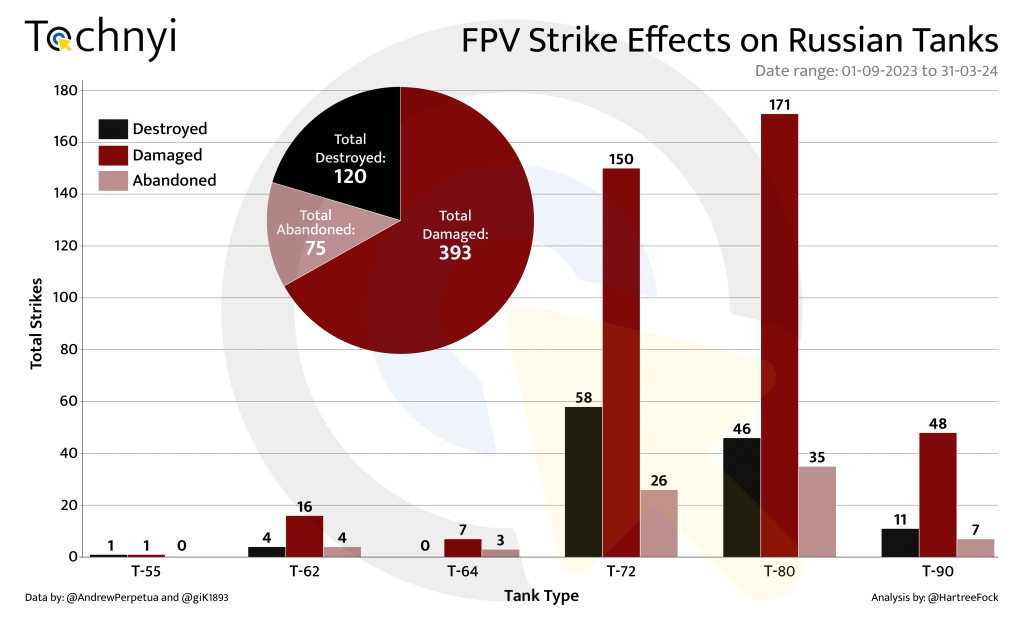
When diving into the data across months we can observe a consistent attrition of both the T72 and T80 platforms. The T72 has been present on the battlefield in large numbers over the entire period under examination and this is reflected in the data regarding the consistency of the effective strikes reported, shown in Figure 4. The data set finds an average of 31.7 T72s are currently hit by FPV drones per month.
On several occasions, analysts and public opinion have been divided when discussing the impact of drones, and, more specifically, FPV drones. One school of thought has remained persistent yet unverified: that most strikes on vehicles, particularly tanks, were conducted after the vehicle was incapacitated or in a stationary position. This is mostly true when considering strikes on tanks from drone dropped munition.
However, by analyzing the available footage of FPV strikes on Russian T-72 tanks, it is possible to get a more representative picture of reality. Except for October 2023, the overall share between damaged stationary and moving T-72s is similar, and the overall count slightly favours moving targets. This leads to the conclusion that, based on the data available, FPV drones are not used solely on stationary targets. Due to their agility and speed, they are commonly used on moving targets.
In some videos, FPV drones have been used during defensive operations, engaging tanks that were either on the move or firing on Ukrainian positions.
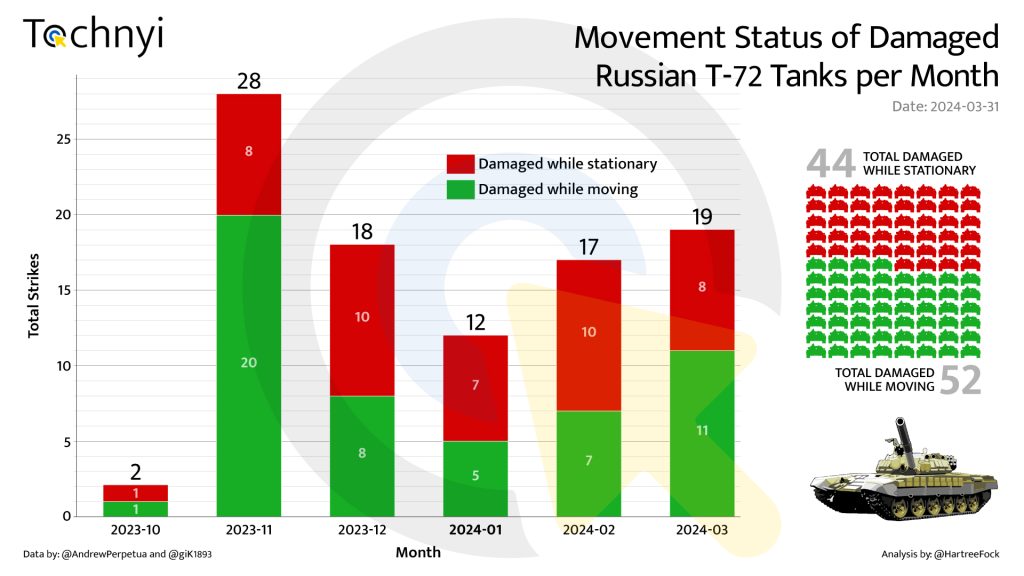
Analyzing the footage of FPV drone strikes on T-72 tanks provides crucial insights into their tactical applications and the resulting damage patterns. Notably, 71.7% of all attacks on T-72 tanks occur in the rear and turret/rear hull areas. This high percentage highlights a strategic targeting approach, aiming at the tank’s vulnerabilities.
The rear and turret/rear hull areas of a tank, including the T-72, often need to be more armoured compared to the front and sides (Figure 5). This makes these sections prime targets for FPV drone strikes. Specifically, attacks on the turret and rear hull account for approximately 33% of all documented strikes. This focus on the turret/rear hull is critical as it often houses the tank’s ammunition storage.
Strikes on the turret and rear hull areas have particularly devastating effects. These sections are not only less armoured but also more likely to expose the ammunition stored in the autoloader. When FPV drones hit these areas, the probability of causing a cook-off is relatively high, leading to catastrophic internal explosions and fires. Such strikes frequently result in the near-total loss of the vehicle. The internal explosions caused by the cooking off of ammunition can breach the tank’s internal compartments, igniting fuel and causing uncontrollable fires that can destroy the tank.
The agility and speed of FPV drones allow them to approach and strike tanks from these vulnerable angles effectively. Unlike traditional munitions, FPV drones can be guided with high precision to hit specific weak points, increasing the likelihood of disabling or destroying the target. This precision is evident in the footage showing drones manoeuvring around to strike the rear and turret/rear hull areas. This strategic targeting enhances the effectiveness of FPV drones and demonstrates a nuanced understanding of tank vulnerabilities in contemporary warfare.
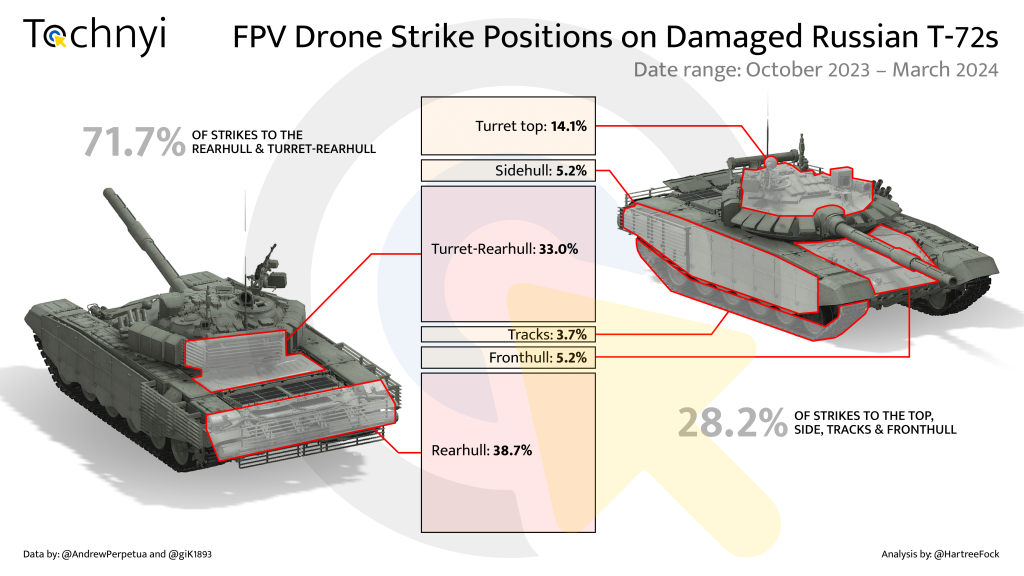
In the scenario depicted in Figure 6, a typical strike on the turret-rear hull area is illustrated. The video footage shows the tank in motion, with the FPV drone initially trailing it undetected. The drone’s high speed allows it to rapidly close the distance to the tank. This phase, which can be named the approaching phase, is critical as it sets up the conditions for a successful strike. During this phase, the drone pilot adjusts the drone’s tilt to gain additional speed and enhance manoeuvrability, which is crucial for maintaining control during the high-speed chase.
As the drone nears its target, the pilot makes further adjustments to the drone’s angle of attack. This involves tilting the drone to approximately 30 degrees relative to the plane of the tank. This final adjustment ensures that the drone strikes the target with the maximum chance of penetration. The increased angle not only optimizes the speed and control of the drone but also aligns the warhead for an effective top-down impact, targeting the tank’s weaker armor.

The T-72 main battle tank, first introduced by the Soviet Union in 1969, has undergone significant armor enhancements over the years. These upgrades have been particularly focused on the tank’s top armor, especially around the turret, to improve its defensive capabilities against modern threats such as anti-tank guided missiles (ATGMs) and kinetic penetrators.
The top armor of the T-72 varies depending on the specific model. For instance, the T-72B, includes additional armor on the turret and hull front. This model is equipped with Kontakt-5 explosive reactive armor (ERA), which significantly enhances protection against both kinetic energy projectiles and chemical energy projectiles like high-explosive anti-tank (HEAT) rounds. The turret armor of the T-72B is estimated to provide protection equivalent to approximately 450 mm of rolled homogeneous armor (RHA) [2].
Despite these enhancements, the top armor of the T-72, particularly in earlier models, remains vulnerable to modern top-attack munitions. The armor over the engine deck and turret top is notably thinner than the frontal armor, designed primarily to withstand less direct fire. This makes it susceptible to attacks from above, where the armor is less reinforced [3-4].
This vulnerability is critical because top-attack weapons, like the RBS 56 BILL anti-tank guided missile (Figure 7), are designed specifically to exploit this weakness. The BILL missile system features a warhead that is angled downwards, designed to detonate above the tank, directing its explosive force downward to penetrate the thinner top armor. This design choice is particularly effective against the T-72 and similar tanks, as it can bypass the more heavily armored sections and strike where the armor is less robust. The missile’s warhead detonates at an optimal angle to maximize the penetration potential against the relatively thinner top armor, thereby increasing the likelihood of achieving a catastrophic kill (Figure 7).

The T-72 has notoriously thin armor in the area between the turret and the engine compartment (Figure 8), as is evident from the image below. Such a thin layer of steel should not be surprising, not only due to the Russian tendency to cut corners to produce tanks more cheaply and quickly but also because of the environments in which most of these tanks have been designed to operate.
FPV drones, thanks to their high manoeuvrability and the skill of their pilots, can exploit this vulnerability, making them more effective than initially anticipated.
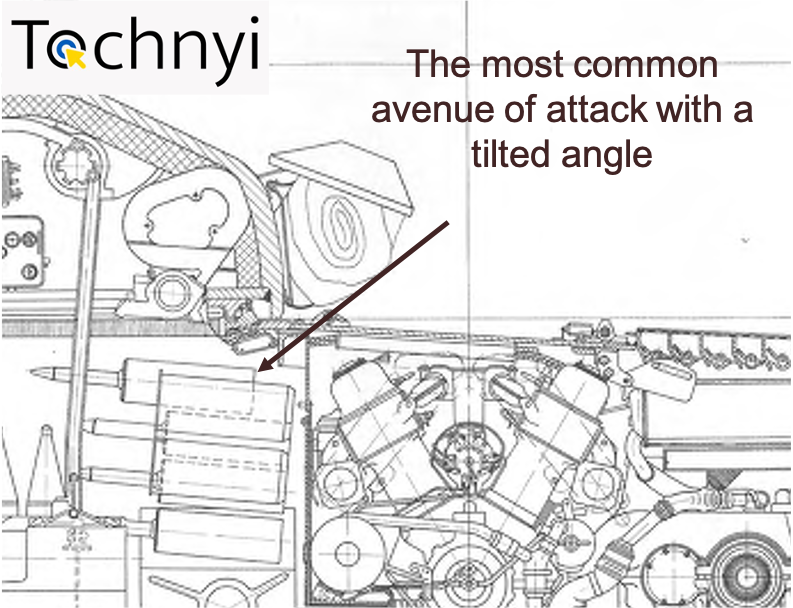
It’s important to investigate the locations where Russian tanks have been attacked. One significant scenario is the flat area on the outskirts of Avdiivka, composed of multiple fields separated by three lines. Figure 9 presents a map with geolocated tanks and pictures of the strikes taken from associated videos. The tanks have been struck mostly on streets and in open fields, particularly close to tree lines. This aligns with the current situation on the ground, where Russians attempt to move rapidly on roads to cover long distances. However, once halted, they try to advance through fields, putting the tank crews in additional danger from artillery, minefields, and FPV drone strikes.
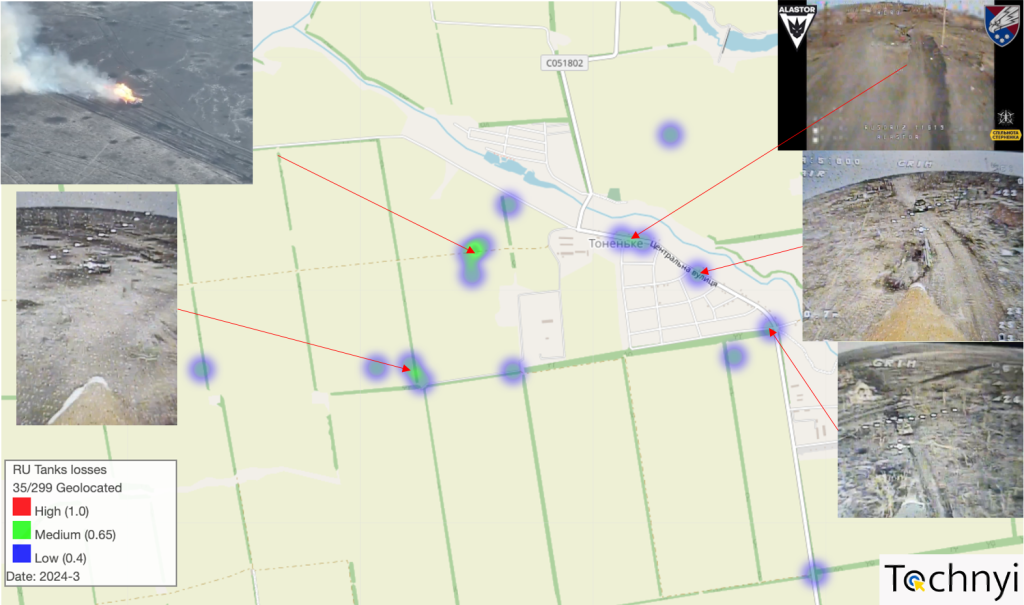
The Russian response: The Turtle Tank
In the rapidly evolving landscape of the war in Ukraine, the Russian military has introduced an unconventional armoured vehicle known as the “Turtle Tank”. These modified tanks, primarily T-72 and T-62 models, have been adapted to counter the increasing threat of explosive drones employed by Ukrainian forces.
The Turtle Tank, or as many Ukranian soldiers call it “Garden shed”, derives its name from the distinctive metal roofs added atop its hull and turret, resembling a turtle’s shell (Figure 10). This retrofitted armor is, in theory, designed to mitigate the threat posed by FPV drones, which are inexpensive, easy to produce, and capable of causing significant damage to conventional armored vehicles. The tanks are often equipped with electronic warfare (EW) jammers to further enhance their defense against drone attacks [5-6].
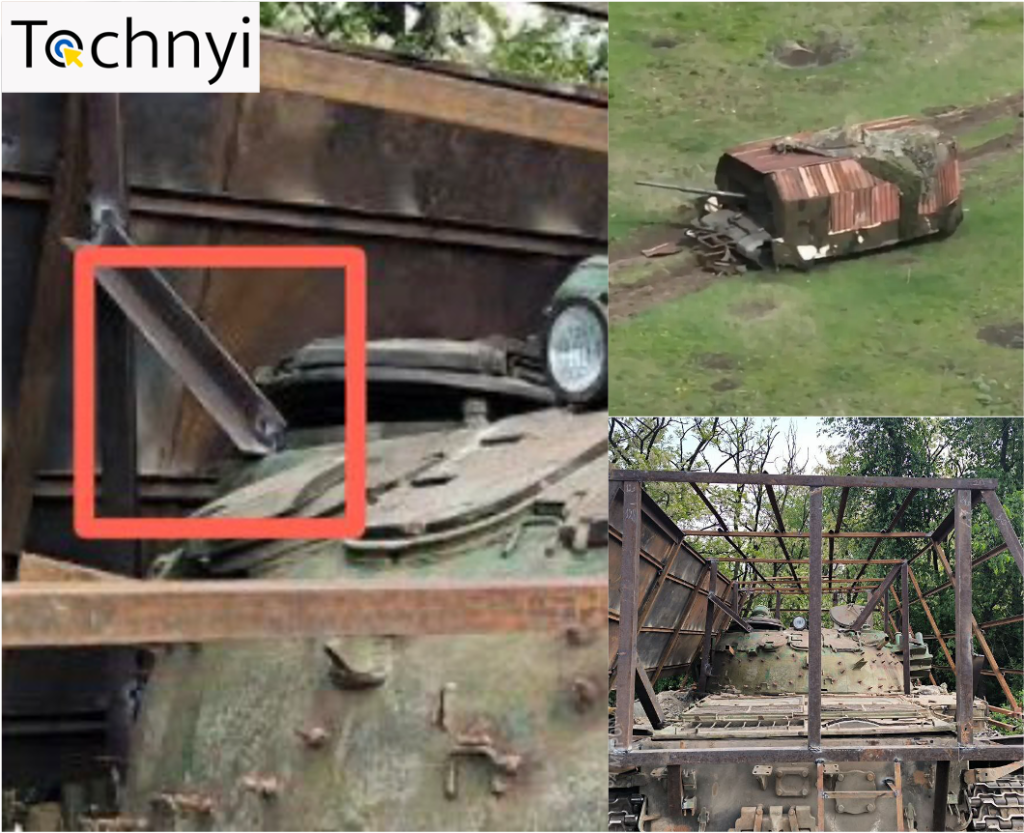
The metal roof serves as an additional layer of protection, aiming to deflect or absorb the impact of drone strikes (Figure 9), and always in theory increase the stand-off distance against shape charges. This adaptation reflects the Russian military’s ability to improvise and respond to specific battlefield threats, even if the solutions appear rudimentary or unconventional [6].
The primary advantage of the Turtle Tank lies in its enhanced protection against FPV drones. Ukrainian forces have utilized these drones extensively, launching them in large numbers to target Russian armored vehicles. The improvised armor of the Turtle Tank has proven effective in reducing the damage from such attacks, allowing the tanks to continue their operations despite being hit by multiple drones [7].
Despite their defensive benefits, the Turtle Tanks suffer from several significant drawbacks:
The added metal roof can impede the tank’s movement, making it slower and less agile, which is a critical disadvantage in dynamic combat situations where speed and manoeuvrability are essential. Additionally, the improvised armor restricts or completely eliminates the rotation of the tank’s turret, limiting its ability to engage targets effectively from different angles, thereby reducing operational flexibility and hampering the tank’s combat effectiveness. Moreover, the additional armor reduces the visibility for the tank crew, making it more challenging to navigate the battlefield and spot potential threats. Finally, while potentially effective against drones, the Turtle Tank’s armor provides little defense against heavier weapons such as artillery shells and anti-tank missiles. This limits its overall survivability in high-intensity combat scenarios [5,7].
The Turtle Tank first appeared on the battlefield outside Krasnohorivka, west of Donetsk, and has since become more common along the front lines. Initially used by the 5th Motor Rifle Brigade, these tanks have also been spotted in better-equipped units like the 90th Tank Division. The widespread adoption of Turtle Tanks indicates a broader acceptance of this improvised solution within the Russian military [6,7].
The tanks have primarily been used to transport infantry closer to enemy positions, leveraging their enhanced drone protection to maintain operational capability in contested areas. This role highlights the adaptive nature of the Turtle Tank in meeting the immediate tactical needs of Russian forces [5].
The introduction of Turtle Tanks underscores the evolving nature of modern warfare, where traditional armored vehicles must adapt to new threats like drones. However, the effectiveness of these tanks have been short-lived as Ukraine continued to receive more advanced weaponry from Western allies, including artillery shells and Javelin missiles. These threats will render the Turtle Tanks’ drone-specific adaptations insufficient, challenging their continued viability on the battlefield [5].
In addition, as depicted in Figure 11, Ukrainian FPV drone pilots showcased how additional layers of protection can be penetrated using more drones and exploiting the exceptional accuracy of the drones. In a specific strike, a turtle tank was targeted three times. The initial two hits targeted the sides, but due to the multiple layers of protection, they were ineffective. However, the third strike targeted the tank tracks, which effectively immobilised the Turtle Tank, forcing the crew to abandon the vehicle. This is just one example of several situations where these “new” weapon systems have been overcome.
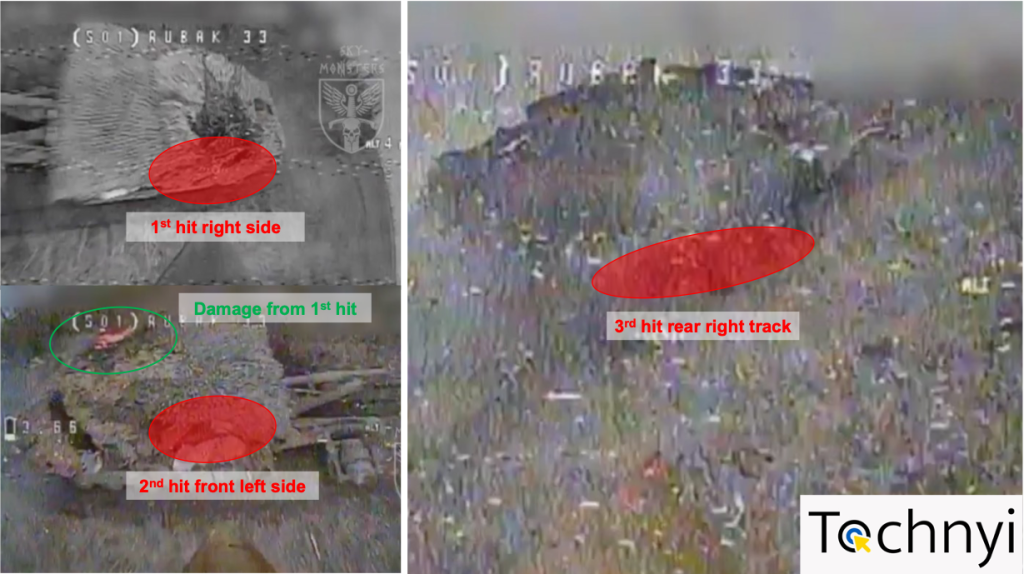
Conclusions
The utilization of FPV drones in the Ukrainian war, specifically against Russian tanks, highlights the dynamic evolution of modern warfare. This analysis, drawing from the available data, underscores several key insights into the impact of these drones on the battlefield.
The data indicates a substantial and growing reliance on FPV drones by Ukrainian forces to target Russian tanks and armored vehicles. From September 2023 to March 2024, there has been a significant increase in FPV drone strikes, with the highest activity recorded in March 2024. The consistent damage inflicted on T-72 and T-80 tanks, the most affected models, demonstrates the effectiveness of FPV drones in compromising these key components of Russia’s armored forces.
The financial impact of FPV drone strikes on Russian tanks is substantial, amounting to an estimated $1.52 billion over the analyzed period. FPV drones have shown a high degree of agility and precision, targeting the vulnerabilities of tanks, particularly in the rear and turret/rear hull areas for T72 tanks. This strategic targeting approach has proven effective in causing significant damage, often leading to catastrophic internal explosions. The footage analysis reveals that FPV drones are used on both stationary and moving targets, highlighting their versatility in various combat scenarios.
In response to the growing drone threat, the Russian military has introduced the “Turtle Tank”. While these adaptations provide enhanced protection against FPV drones, they have significant drawbacks, including reduced mobility, limited turret functionality, and decreased visibility. The Turtle Tank represents a temporary measure in the ongoing adaptation to drone warfare, illustrating the continuous chase between both parts, but also a sign of desperation exacerbated by the situation on the ground that the Russian mechanised troops are facing. In the evolving nature of the war in Ukraine, both sides continue to innovate and adapt their tactics and technologies. Introducing more advanced warheads and guidance systems on FPV drones will further challenge the efficacy of Russian armored vehicles on the battlefield.
References
[1] https://www.washingtonpost.com/world/2023/02/16/russia-army-tanks-ukraine-losses/
[2] https://man.fas.org/dod-101/sys/land/row/t72tank.htm
[3] https://thesovietarmourblog.blogspot.com/2017/12/t-72-part-2.html
[4] https://below-the-turret-ring.blogspot.com/2015/06/the-armor-protection-of-t-72-tank.html].
[6] new-russian-turtle-tank-with-cage-like-armor-emerges-on-ukrainian-battlefield